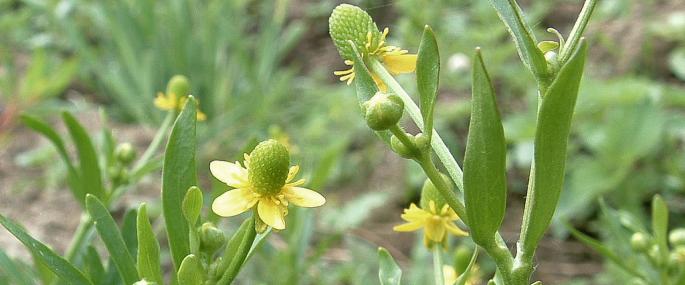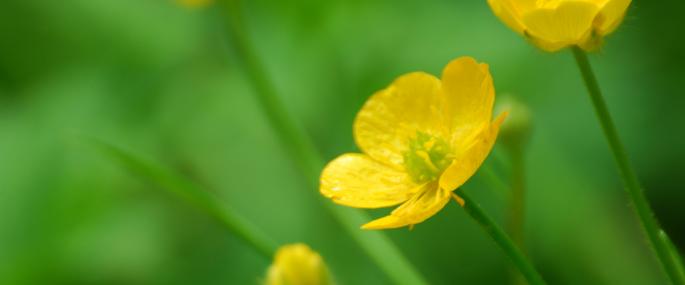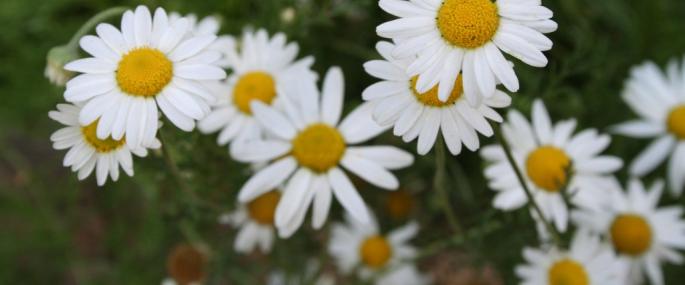Traveller's-joy
Traveller's-joy is a climbing plant that scrabbles over bushes along hedgerows, woodland edges and scrubby grassland on limestone soils. This wild clematis produces a mass of scented flowers in late summer and is pollinated by bees and hoverflies. The seeds are also eaten by many birds such as Goldfinches and Greenfinches.
The loss of many of our hedgerows in the countryside mean that ornamental shrubs and hedges in our gardens provide vital food and shelter for a range of wildlife including butterflies, birds and small mammals. To encourage wildlife into your garden, try planting hedges of native species, including climbers like Traveller's-joy. To find out more about wildlife-friendly gardening, visit our Wild About Gardens website: a joint initiative with the RHS, there's plenty of facts and tips to get you started.

Columbine
Columbine is a tall plant of woodland rides, fens and damp places, and is also a favourite cottage-garden plant, various forms often escaping into the countryside. Its nodding, bonnet-shaped, purple flowers appear in May and June and will self-seed in a garden to provide a colourful and wild border, great for nectar-loving bees.
Human activity, including the drainage of land for agriculture, the loss of ponds through development and the removal of wet woods, has resulted in the disappearance of many of the UK's wetlands. The Wildlife Trusts are working closely with planners, developers and farmers to ensure our wetlands are protected. You can help too: plant Columbine and other natives in borders to provide early nectar for insects. In partnership with the RHS, The Wildlife Trusts' Wild About Gardens initiative can help you plan your wildlife garden.
Marsh-marigold
The large golden flowers of Marsh-marigold certainly look like the cups of kings and the Latin name Caltha is derived from the Greek for 'goblet'. Hence, Marsh-marigold is also commonly known as 'Kingcup'. It is a widespread plant of ponds, marshes, damp meadows, ditches and wet woodland and, before the draining of the landscape for agriculture began, was a conspicuous spring flower.
Human activity, including the drainage of land for agriculture, the loss of ponds through development and the removal of wet woods, has resulted in the disappearance of many of the UK's wetlands. The Wildlife Trusts are working closely with planners, developers and farmers to ensure our wetlands are protected. You can help too: plant Marsh-marigolds and other natives around a wildlife-friendly pond and provide shelter for frogs and early nectar for insects. In partnership with the RHS, The Wildlife Trusts' Wild About Gardens initiative can help you plan your wildlife garden.

Lesser Celandine
Lesser Celandine is a characteristic spring flower of woodlands, hedgerows, graveyards and parks where its shiny flowers can carpet area with gold between March and May. Despite its name, it is not actually a close relative of Greater Celandine, and is a member of the buttercup family instead.
The Wildlife Trusts manage many woodland nature reserves sympathetically for a range of spring flowers, from golden Lesser Celandine to fragrant Ramsons, showy Bluebells to delicate Wood Anemones. A mix of coppicing, scrub-cutting and ride maintenance open up the woodland floor to the sun, helping many flowers and plants to thrive. You can help too: volunteer for your local Wildlife Trust and you could be involved in everything from traditional forest crafts to raising awareness about woodland wildlife.
Celery-leaved Buttercup
Celery-leaved Buttercup is a common plant of damp places, wet meadows and the muddy edges of ponds and ditches, clinging on even if the pond has dried out. Its tiny flowers appear from May to September.
The Wildlife Trusts manage many grassland and wetland habitats sympathetically for the benefit of all kinds of wildlife. We are also working closely with farmers, landowners and developers to promote wildlife-friendly practices. We have a vision of a 'Living Landscape': a network of habitats and wildlife corridors across town and country, which are good for both wildlife and people. You can support this greener vision for the future by joining your local Wildlife Trust.

Meadow Buttercup
Meadow Buttercup is a widespread and common perennial in meadows and pastures, and is also found in parks, gardens and woodland edges. It prefers slightly damper, calcareous sites where it can grow so dense, it forms yellow meadows that dazzle in the sunshine. It flowers between April and October.
The Wildlife Trusts manage many grassland and woodland habitats sympathetically for the benefit of all kinds of wildlife. We are also working closely with farmers, landowners and developers to promote wildlife-friendly practices. We have a vision of a 'Living Landscape': a network of habitats and wildlife corridors across town and country, which are good for both wildlife and people. You can support this greener vision for the future by joining your local Wildlife Trust.

Creeping Buttercup
Creeping Buttercup is the common buttercup found in grassland, damp places, along woodland and field edges, and in parks and gardens. It flowers mainly between May and August and long, rooting runners help it to spread across lawns, much to the dissatisfaction of some gardeners. Yet this golden-cupped flower is a childhood favourite: if a yellow reflection appears when held up to the chin, it is considered as a sign that the person likes butter.
Our gardens are a vital resource for local wildlife, providing corridors of green space between open countryside, allowing species to move about. In fact, the UK's gardens provide more space for nature than all the National Nature Reserves put together. Try leaving wilder areas in your garden, such as patches of flowers like buttercups in your lawn and nettles near the compost heap, and see who comes to visit... To find out more about wildlife-friendly gardening, visit our Wild About Gardens website: a joint initiative with the RHS, there's plenty of facts and tips to get you started.

Chamomile
Chamomile is often first noticed when crushed under foot as it releases a distinctive, apply fragrance. The smell of Chamomile, coupled with its cushion-soft feel, made the plant so popular in Elizabethan times that herb gardens often contained Chamomile lawns and seats. Chamomile flowers from June to August and can be found along coastal cliffs, in grasslands and on commons. Here, livestock keep its natural scrambling form is well-clipped, just like in the herb gardens of yesteryear.
Once found throughout the UK, Chamomile is now scarce and restricted mostly to the south and south-west of England; this is mainly due to habitat loss and the decline of livestock-grazing, particularly on commons. The Wildlife Trusts are working closely with farmers and landowners to promote wildlife-friendly practices. We have a vision of a 'Living Landscape': a network of habitats and wildlife corridors across town and country, which are good for both wildlife and people. You can support this greener vision for the future by joining your local Wildlife Trust.

Heather
Heather is also known as 'Ling' and is an abundant plant on heathland, moors, bogs and even in woodland with acidic or peat soils. Its delicate pink flowers appear from July to October and are a contrast to the tough, wiry, sprawling stems they grow upon. Plants grow tightly-packed together and can live for up to 40 years or even older.
Purple-carpeted heaths are an iconic feature of the UK's landscape and are the result of hundreds of years of low-impact human activities such as livestock-grazing and scrub clearance. Yet development and the decline of traditional farming methods have caused many of these precious habitats to be lost - over 80% of lowland heathland in the UK has disappeared in just 200 years. The Wildlife Trusts manage many heathland habitats for the benefit of wildlife; by volunteering for your local Trust you can help too, and you'll make new friends and learn new skills along the way.

Bell Heather
Bell Heather is found in a variety of harsh habitats including heathland, acidic soils, open woodland and even coastal areas. It particularly likes dry, well-drained soils. The dark purple-pink, bell-shaped flowers appear between July and September, carpeting heathlands and bringing them to life with the buzzing of nectar-loving bees and insects.
Purple-carpeted heaths are an iconic feature of the UK's landscape and are the result of hundreds of years of low-impact human activities such as livestock-grazing and scrub clearance. Yet development and the decline of traditional farming methods have caused many of these precious habitats to be lost - over 80% of lowland heathland in the UK has disappeared in just 200 years. The Wildlife Trusts manage many heathland habitats for the benefit of wildlife; by volunteering for your local Trust you can help too, and you'll make new friends and learn new skills along the way.